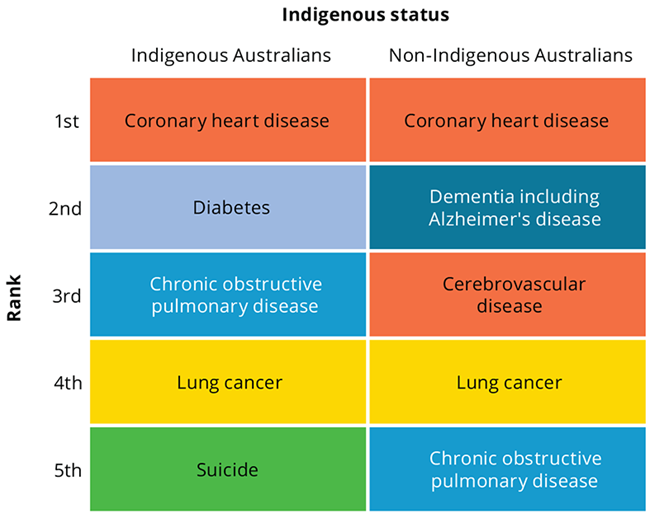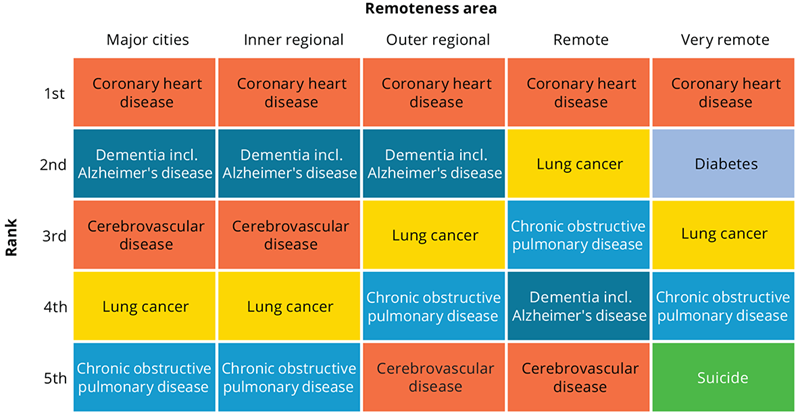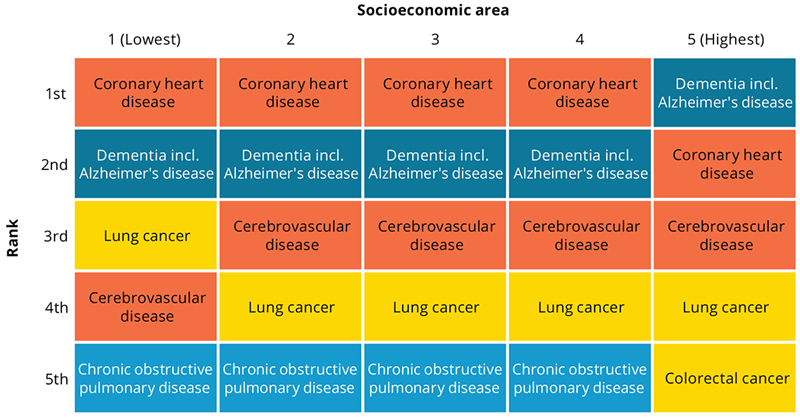Variation in deaths between population groups
Rates of death and leading causes of death differ between population groups. This may be driven by variations in the population characteristics, causes of death at different ages, characteristics of the place where people live, the prevalence of illness and risk factors, and access to health services.
Deaths reported in this section are over a 5-year period combined (2017–2021), and rates are reported as crude rates in the first instance, followed by age-standardised rates to allow comparisons to be made between population groups with differing age structures.
Aboriginal and Torres Strait Islander peoples
Rates of death and leading causes of death differ between population groups:
- In the period 2017–2021, the crude death rate for Aboriginal and Torres Strait Islander people was 455 per 100,000 population. The crude death rate for non-Indigenous Australians was 659 per 100,000 population.
- The age-standardised death rate among Indigenous Australians was 1.8 times the rate among non-Indigenous Australians (941 deaths per 100,000 population, compared to 532 per 100,000 respectively).
- The 5 leading causes of death for Indigenous Australians were coronary heart disease, diabetes, chronic obstructive pulmonary disease (COPD), lung cancer and suicide. Diabetes and suicide were not among the 5 leading causes of death for non-Indigenous Australians (Figure 6.1).
- While coronary heart disease was the leading cause of death for both Indigenous and non-Indigenous Australians, the age-standardised death rate for Indigenous Australians was 2.0 times as high as for non-Indigenous Australians. For diabetes it was 4.8 times as high and for COPD it was 3.2 times as high.
See Indigenous life expectancy and deaths.
Figure 6.1: Leading underlying causes of death in Australia, by Indigenous status, 2017–2021

Note: Cause of death data by Indigenous status are restricted to those 5 states and territories where information on Indigenous status is considered of sufficient quality and completeness of reporting: New South Wales, Queensland, Western Australia, South Australia and the Northern Territory.
Source: AIHW National Mortality Database; Table S6.1.
Remoteness areas
Rates of death and leading causes of death differ between the areas where people live:
- In 2017–2021, the crude death rate was highest in Inner regional areas (834 per 100,000 population), followed by Outer regional areas, Remote areas, Major cities and was lowest in Very remote areas (554 per 100,000 population).
- The age-standardised death rate increased with increasing remoteness. In Very remote areas, the age-standardised mortality rate was 1.6 times the rate in Major cities (768 and 488 deaths per 100,000 population respectively).
- Coronary heart disease was the leading cause of death across all remoteness areas (Figure 6.2); in Very remote areas, the age-standardised death rate was 1.9 times the rate in Major cities (94 and 51 deaths per 100,000 respectively).
- Diabetes was the second leading cause of death in Very remote areas and seventh in Major cities – the age-standardised death rates were 3.8 times as high in Very remote areas as in Major cities (55 and 14 deaths per 100,000 respectively).
- Dementia including Alzheimer’s disease had a lower ranking in Remote and Very remote areas (ranked fourth and seventh respectively) compared with Major cities and Regional areas (ranked second).
- The top 5 causes of death in Very remote areas were the same as for the total Indigenous population – coronary heart disease, diabetes, lung cancer, COPD and suicide.
- In Very remote areas, the age-standardised death rates for suicide were 2.3 times as high as in Major cities (25 and 11 deaths per 100,000 respectively).
Figure 6.2: Leading underlying causes of death in Australia, by remoteness area, 2017–2021

Source: AIHW MORT books
Socioeconomic areas
Rates of death and leading causes of death differ between socioeconomic groups:
- In the period 2017–2021, the crude death rate was highest in the lowest socioeconomic area (782 per 100,000) and decreased with increasing socioeconomic position. The crude death rate in the highest socioeconomic area was 526 per 100,000.
- The same trend was seen with age-standardised death rates. For people living in the lowest socioeconomic areas, the age-standardised death rate was 1.5 times the rate for people living in the highest socioeconomic areas (610 and 416 deaths per 100,000 respectively).
- Four leading causes of death were common across all 5 socioeconomic areas – coronary heart disease, dementia including Alzheimer’s disease, cerebrovascular disease and lung cancer (Figure 6.3). Colorectal cancer was the fifth leading cause of death for the highest socioeconomic area, while in the other socioeconomic areas it was COPD.
- Age-standardised death rates for coronary heart disease decreased with increasing socioeconomic position (42 deaths per 100,000 in the highest socioeconomic area, compared to 67 per 100,000 in the lowest). Coronary heart disease was the leading cause of death in all areas except the highest, where dementia was the leading cause.
- Age-standardised death rates for dementia were similar across each socioeconomic area, and it is the 2nd leading cause of death across all areas except the highest (where coronary heart disease is the 2nd leading cause).
- For people living in the lowest socioeconomic area, age-standardised death rates for diabetes, COPD and lung cancer were at least twice those for people living in the highest socioeconomic area (diabetes: 23 and 10 deaths per 100,000 respectively; COPD: 32 and 13 deaths per 100,000 respectively; and lung cancer: 37 and 18 deaths per 100,000 respectively).
See Health across socioeconomic groups.
Figure 6.3: Leading underlying causes of death in Australia, by socioeconomic area, 2017–2021

Source: AIHW MORT books


